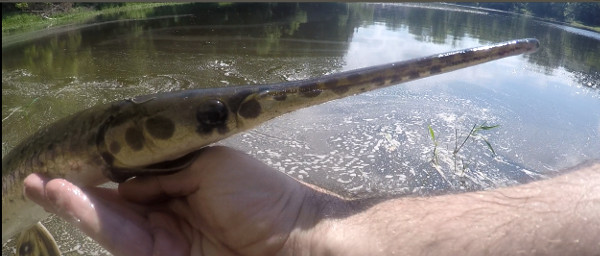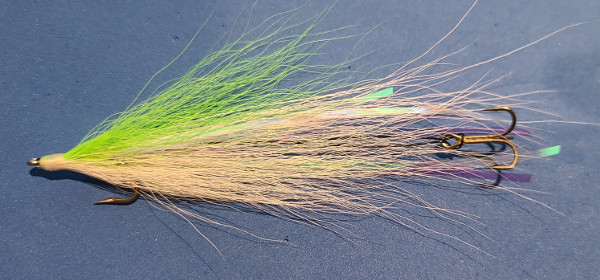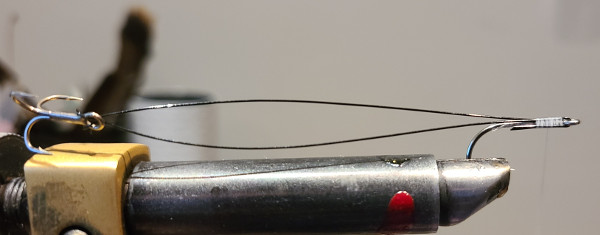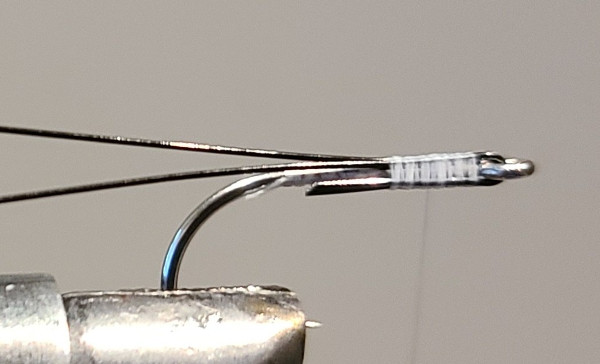
Fly fishing for longnose gar not only offers an opportunity to target an oddball fish, but it’s also tons of fun! These prehistoric fish readily take most fly presentations and put up a good fight as well. I’m honestly surprised it’s not more popular.
Most gar fly fishing is quite visual. You will often be sight fishing. Casting and retrieving streamers past the nose of a gar basking in the sun. If you’re lucky, the gar will slowly get itself in position before quickly striking at your fly. This is followed by an explosive fight if you successfully hook up.
These fish are much stronger and more energetic than they first appear. Longnose gar are impressively acrobatic. You can expect impressive jumps head thrashing when you hook into one of these fish. All in all, gar offers an exciting sport fishery that is underutilized.
The advice and experience below is specifically for targeting longnose gar on the fly. The advice can also be applied to fly fishing for spotted gar, Florida gar, and shortnose gar.
The biggest gar species is the alligator gar. Much of the information listed below can be used to target these beasts as well… but you’ll need to size everything up (fly rod, fly line, flies, etc).
When and Where to Fish for Gar
The best gar fishing is during the long, hot days of summer when many other fish species become lethargic.
Gar like slow-moving water, and sometimes even stagnant water. They have “primitive lungs” that are actually vascularised swimbladders. These “lungs” allow them to take advantage of habitats with oxygen-poor water. While many species of fish would suffocate in oxygen-poor water, gar can take a breath of air instead of relying solely on their gills.
This is actually one of the ways to easily find gar. When you get to a new fishing spot, take some time to scan the water surface before you start fishing. You’ll often see gar raise their snout out of the water as they take a gulp of air.
You’ll often find them sunning themselves in back bays, on the downstream side of the island, or anywhere on wide-open flats. Basically anywhere with little to no current, and some prey species present. Preferred prey is minnows, but they could also be feeding on frogs in a stagnant back bay.
You might be thinking lakes and ponds are ideal habitats for gar, but I’ve actually had more luck finding them on larger rivers with plenty of calm areas.
If there’s alot of boat traffic around, try finding a more secluded spot. Heavy boat activity will often drive gar from the surface (making them difficult to target), or from the area altogether.
How to fly fish for Gar
Gar are not as spooky as trout or carp, but it’s still possible to scare them. Try not to throw shadows on them, or make too much noise when approaching the fish.
Cast a streamer past the nose of the gar, ideally perpendicular to the fish. You want the streamer to be retrieved a few inches in front of its snout. The gar should snap at the fly as it passes infront of the fish. Alternatively, the gar may follow the fly for a short while before striking.
Generally, a fairly slow retrieve works well. As with all fly fishing though, vary your retrieve if it doesn’t work the first time.
Given the bony mouths of these fish, getting a good hookset is particularly important. You want a good solid hookset to really drive the hook point into the boney mouths of these fish. When you can see that the gar has the fly in its mouth wait a few seconds. Let the gar chew on it a bit. Then make a single solid stripset to secure the fly (no troutsets here!). A second firm strip set after the first one doesn’t hurt, just to really make sure the hook point has been driven home.
A quick rundown on strip sets vs trout sets. Strip set has you pointing the rod directly at the fish, and stripping the fly line back to set the hook. You don’t raise and put a bend in the rod until after the hook has been set. This is opposed to a trout set, where you jerk the whole rod back, and some of the power of the hookset gets lost in the bend of the rod.
Hopefully, the gar grabbed the fly in such a way that it’s in its mouth perpendicular to the snout. the idea is that you pull the fly out of the fish’s mouth, with the trailer hook penetrating the fish’s mouth as you do so. It’s much less likely that you’ll get a good hook hookset if the fly isn’t perpendicular to the gars mouth, but a strike is a strike and you still have to try!
Best Flies for Gar

Longnose gars are highly piscivorous (eat fish), so you’re going to be using streamer flies to target them. These fish are not very picky eaters, and will snap at any appropriately sized prey item that is within striking distance. Most basic streamer patterns work quite well, and I usually use a simple bucktail streamer (such as the one pictured above). Using a streamer that is almost neutrally buoyant helps, as ideally, you’ll be fishing these flies just under the surface.
The main difference in gar flies when compared to other flies, is that you need a trailer hook to properly hook up. Gar have narrow, bony jaws that they use to snap up small fish. A typical fly with a single hook just isn’t going to have a good hookup rate. There are two ways around this. Either use a small-sized trailer treble (preferred), or a rope fly (not preferred, will cover why below).
A gars long snout is well adapted to snapping up smaller baitfish efficiently. At first glance, you may think these fish require large streamers like pike or musky, but that’s not the case. Most of the gar I’ve caught have been on smallmouth bass sized flies in the 3″ to 5″ flies. I know these are large to traditional trout fly anglers, but they’re quite small when compared to flies used for similar-sized pike and musky.
Treble Trailer
Longnose Gar do not capture prey by engulfing them as a trout or bass would. Instead, they seize the fish in their elongated snout fill with many needle-like teeth. The gar then works the prey back to the rear of their mouth.
We need to modify our fly to better address a gars snout, and feeding behavior. If you only have a single front hook, you’re going to pull the hook straight out of the gar’s mouth. My preferred way of tying gar flies is to incorporate a small barbless trailer treble hook to counter this. You strip set when the gar has a hold of the fly. This pulls the fly out of the gar’s mouth, but the trailer hook should hook up while doing so.
Hook selection

There are two main hooks in a gar fly. The front hook, where the pattern is going to be tied on, and the stinger hook, which will be responsible for most of your hookups.
Gar flies are the only time in fly fishing that I use a treble hook. Hook-up rates are about 1/5 even with well-designed flies. A treble hook ups your chances of a hook point actually penetrating the small amount of flesh present on a gars snout.
The treble hook should be barbless (or have very small barbs) for two reasons. First, a barb gives some extra resistance when setting the hook. You want the hook to slide into the snout with as little resistance as possible. Secondly, gar are not the easiest fish to unhook, and using barbless hooks makes unhooking any fish much easier.
The primary consideration for the front hook is that it has enough room to securely tie your trailer wire to it, and enough room to tie the actual fly pattern. You don’t actually even need to use a hook for the front. You could use plain metal wire shanks instead.
Unfortunately, there isn’t much opportunity to make the fly weedless. The trailer hook is likely to pick up any weeds you come across. Be mindful when casting gar flies around vegetation.
Wire selection and tie in
I use Beadalon 0.018-Inch (Amazon Link) for the trailer hooks on my fly. If I’m doing a particularly long trailer hook, I may use Berkely’s 7 strand uncoated wire (27lb) instead, as it’s a bit stiffer. You want a wire with some flex, but it should be stiff enough to hold the treble relatively straight from the rear of the fly.
I probably go a bit overkill when tying the wire to the hook. See below for a picture of how I tie my wire in on gar flies (not for all flies, note on orientation further down). Lash the wire down on the top towards the hook eye. Then push both ends of the wire through the hook eye and fold them underneath the hook. INext, secure the bottom pieces of wire as well. Finally, I wrap the entirety of the wire from the hook eye to hook ben in firm thread wraps. I finish with a few half hitches or even a whip finish before proceeding to tie the actual fly.
If you’re using uncoated wire, forgo pushing the wire through the hook eye. The coarse nature of uncoated wire can cut your fishing line tied to the fly.
Be careful when doing thread wraps over the cut wire. It can easily cut your thread. Slower, more purposeful thread wraps around the end of the wire helps prevent this, as does using thicker thread.
A fish won’t budge this, that wire isn’t coming loose. If you need extra confidence, you can apply some superglue to the wire & thread wraps before doing your final pass of thread wraps.

A quick note on wire orientation. With a treble hook, the orientation of the hook doesn’t matter as much. So as you can see above, I just tie to the top and bottom of the front hook. When tying articulated patterns, or putting a single hook on the trailer, you have to be a bit more purposeful with wire placement. The wires need to be tied to either side of the front hook, so the back end is oriented properly. Not a consideration for gar flies with treble trailer hooks, but good to keep in mind for other patterns.
Gar teeth are intended for gripping, not slicing. You don’t actually need to use wire for the trailer hook. I use wire because there’s alot of pike and musky in the water I fish, and if I didn’t, they’d bite the fly in half. Thick monofiliment or flourocarbon are valid substitutes for wire if other toothy fish are not a consideration for you.
As an aside, you can also use poppers and other topwater flies with a trailer hook for gar. Gar like to sun themselves near the surface of the water on hot sunny days, so topwater flies are a good option.
It’s worthwhile to have a dedicated fly box just for gar flies (check our here for a cheap DIY way to make your own fly boxes). The trailer hooks have a tendency to get tangled with other flies when stored together. Storing gar flies separately and well spaced will make your flies last longer.
Rope flies
I’ve seen some anglers advocate for using rope flies when targeting longnose gar. I want to address this, as I disagree with this approach. I’ve used rope flies before and found several issues with them.
First an explanation. What is a rope fly? Rope flies actually don’t have a hook at all. The idea with rope flies is to let the gar chew on the fly for a bit after the strike. Gar have many fine sharp teeth, so when they bite into the fly, it results in the rope fly getting tangled in their teeth. You then steadily apply tension and you have the fish “hooked”.
The issue is twofold. Rope flies make life more difficult for both the angler and the fish.
First. Ropes flies take a ridiculous amount of effort to actually “unhook” the fish. This is a major annoyance for the angler. If nothing else, it reduces the amount of time you actually spend fishing as you’ll be frustrated trying to remove the tangled rope fly mess from the gars mouth.
The second point is in regards to a safe release for the fish. The time it takes to remove a rope fly means that the gar is likely not to survive catch and release. Despite the fact that gar are much tougher, and deal with mishandling much better than some other game species like trout.
Rope flies *do* work, but if your intention is catch and release (or a relaxing day on the water), I’d pass on the rope flies.
Gar Fly Fishing Equipment
Fly Rod and Fly Line
You’re going to be casting decent size streamers for gar, so a 7, 8, or 9 weight fly rod and line is appropriate.
Targeting gar involves mostly topwater sight fishing, so you’ll want to use a floating line. Requirements fall somewhere between bass and pike fishing, and I’ve used lines meant for both species to successfully land gar. You’ll want a fly line that can perform in the heat of the summer.
Here’s some more information on pike fly lines, and the RIO Fly Fishing Fly Line Smallmouth Bass Wf8F (Amazon Link) line I have on my 8 weight for throwing bass poppers works quite well for casting streamers to gar.
Gar are not obligatory topwater fish, it’s just easier to target them near the surface as you can sight fish. If you want to try targeting them in deeper water, a sink tip link works as well. If going with a sinking line, I recommend a slow sink link. You want to be able to hover the baitfish in the water column. There’s also no need for a fast sinking line as you won’t be fishing in current.
A medium action fly rod is ideal for targeting gar. You want:
- More accuracy than a fast action fly rod.
- More distance than a slow action fly rod.
- Some level of accuracy better than a fast action rod in presentations, since you’ll be sight fishing.
- The ability to cast relatively far if you’re covering water rather than sight fishing. But gar fishing is usually best on calm days with little wind, so you don’t need a fast action fly rod.
Leader
Despite the teeth, you don’t actually need a wire leader as you do with pike and musky. Gar teeth are designed for gripping (not slicing), so they don’t cut through fishing line as easily. Tying on an abrasion-resistant Flourocarbon or hard mono is sufficient for leaders when fly fishing for gar.
Net
A net isn’t always necessary when trying to land a fish, but I do recommend one when gar fishing. They’re surprisingly fiesty for a fish that spends so much of its time basking in the sun. Be mindful of the fish’s toothy snout. Trying to land a fish by hand that is thrashing around with all those teeth is a recipe for getting cut up.
Pliers
The hook is generally pretty accessible, so you don’t typically have to worry about digging too deep in their mouth full of bony prehistoric teeth. The reason a set of pliers is necessary is the hook could be really dug into the bony mouth of the gar. In this case, you may need some torque to remove the hook.
Jaw spreaders aren’t a bad idea either.
Final Thoughts
Gar fishing is a blast, and an opportunity to target a fish out of the mainstream. If you want to expand your fly fishing horizons further, consider targeting other rarely targeted (on a fly at least) species like walleye, or mooneye.
Or perhaps you’d like to try microfishing on the fly?

My daughter and family will be relocating back to Ottawa this summer, and at some indeterminate time in the future, the Covid may be sufficiently subdued to allow us to visit them.
They used to live in Riverside South and this time bought a house on the other side of the Rideau next to the new bridge recently completed across the river.
There are storm water controlling lagoons located in this area. Would any of them contain gar. Secondly there is a park ( Conservation area?) going toward Manotick on the Manotick side of the river that provides water access. Would this be useful to try?
I live in Moncton, NB and am primarily a flt fisher and tyer.
Thanks for any advise you could provide,
Small world! I live in Ottawa currently and originally am from the Moncton area in NB as well.
I don’t believe longnose gar are in the Rideau, the locks keep them out.
There’s an extremely healthy longnose gar population in the Ottawa river though. The Ottawa river is where I do most of my gar fly fishing.
As for the park, I assume you’re talking about Chapman Mills? It’s a decent fishing spot, but you won’t catch gar there.